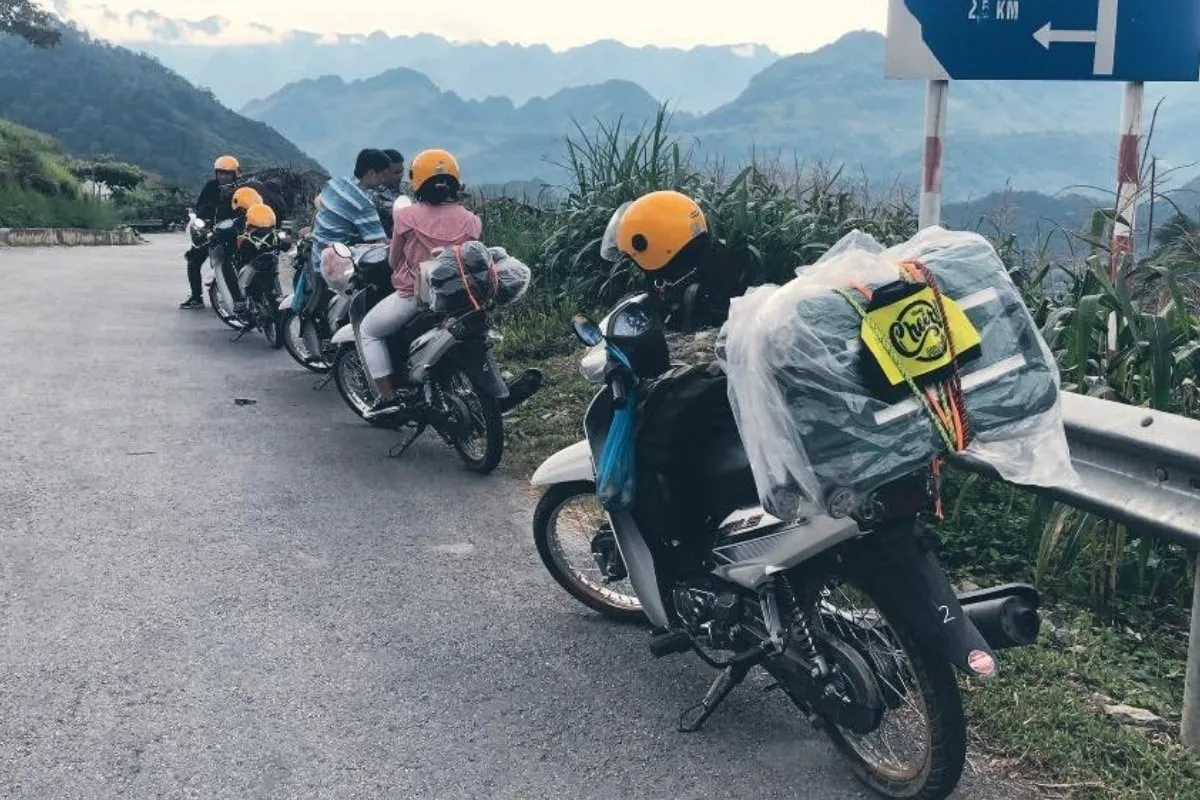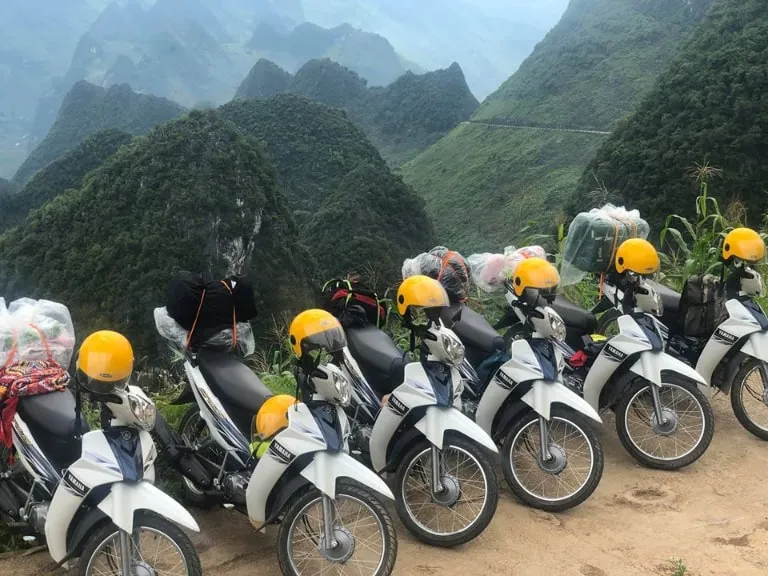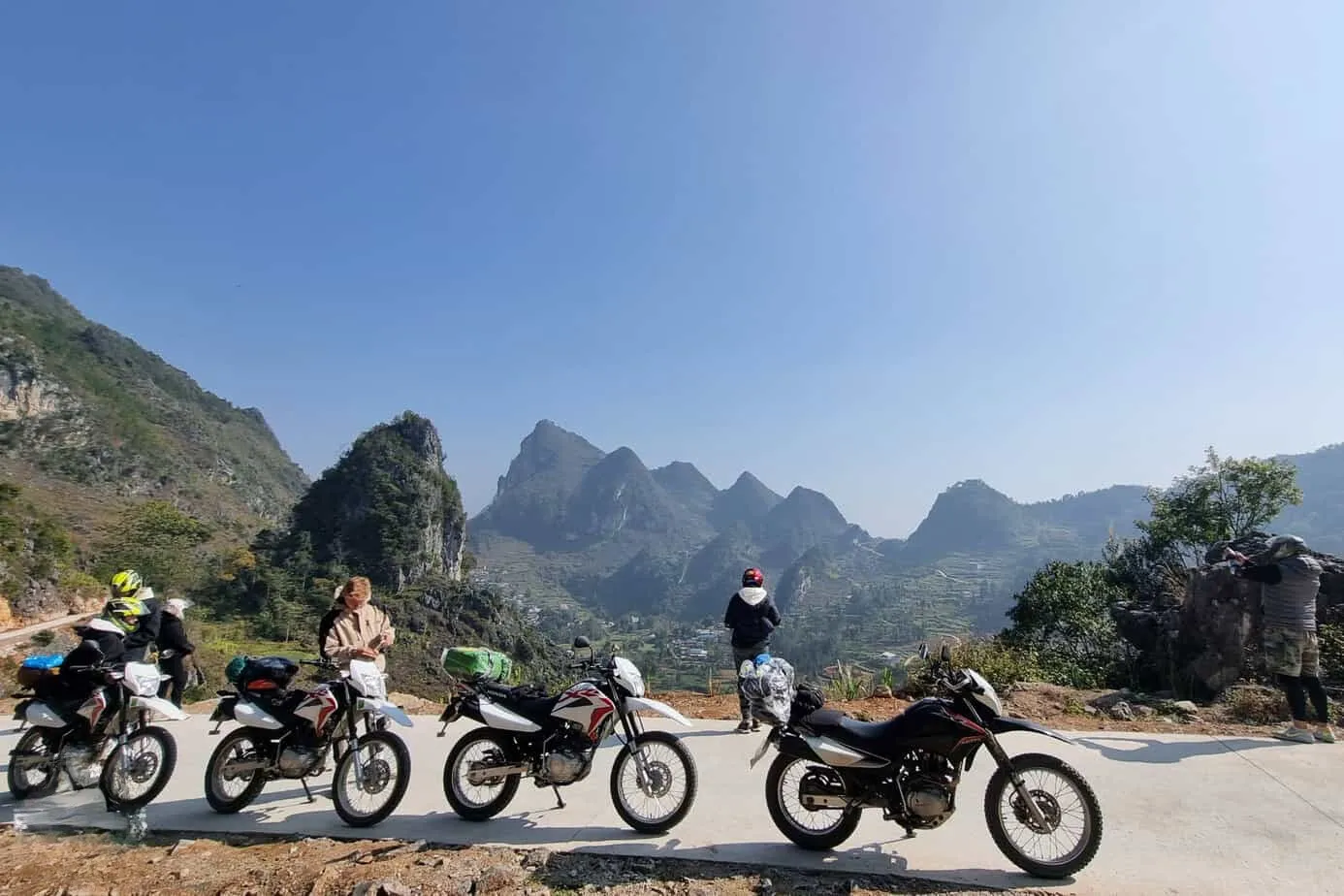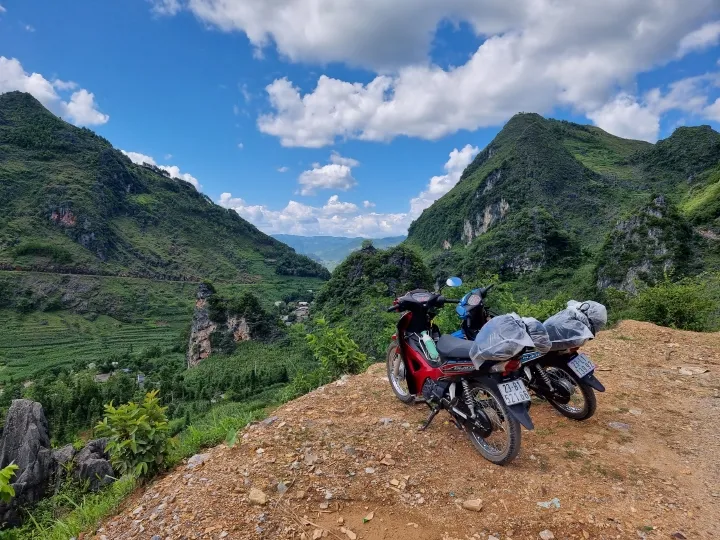The Ha Giang Loop is an unforgettable experience that lets you explore Vietnam’s breathtaking landscapes on a motorbike. However, for a smooth and enjoyable trip, motorbike maintenance is essential. Before you embark on this journey, it’s important to ensure your bike is in optimal condition. In this guide, Karst Plateau will walk you through the necessary motorbike maintenance tips for long Ha Giang Loop trips.
1. Pre-Trip Preparation
Proper preparation is crucial before hitting the road. Here’s what to focus on:
1.1. Inspect the Engine

The engine is the heart of your motorbike, and ensuring it runs smoothly is crucial to a safe and successful trip on the Ha Giang Loop. Proper motorbike maintenance begins with checking the engine oil levels. Low or old oil can cause overheating, which can lead to severe engine damage, especially during long rides in mountainous regions. It’s important to replace the oil if it appears dirty or hasn’t been changed in a while. Always check for any signs of oil leaks or strange smells, as these could indicate deeper issues that require immediate attention.
Additionally, inspect the coolant level in the engine. Coolant helps to regulate the engine’s temperature, preventing overheating on tough climbs and during long hours of riding. Low coolant levels can cause your bike to overheat quickly, which is why monitoring this is an essential part of motorbike maintenance.
Finally, don’t forget the air filter. This component plays a vital role in ensuring your engine receives a clean air supply, which is especially important for optimal combustion. Riding through the dusty roads of the Ha Giang Loop can clog the air filter, reducing engine efficiency and increasing fuel consumption. Clean or replace the air filter if it’s dirty, as a clean filter can improve your engine’s performance and ensure a smoother ride.
1.2 Check the Brakes

Brakes are among the most critical safety features on your motorbike, especially when tackling the rugged terrain and challenging routes of the Ha Giang Loop. Proper motorbike maintenance involves a thorough inspection of both the front and rear brakes before you set off on your journey.
Start by checking the brake pads. The pads should have adequate thickness; if they are worn down too much, they won’t provide the stopping power you need. Squeaking or grinding noises when applying the brakes are signs that the pads may need replacing. This is a key part of essential motorbike maintenance.
Next, inspect the brake fluid. Brake fluid is crucial for proper brake function. If the fluid is low or has darkened, it indicates that it may need a refill or replacement. Contaminated brake fluid can affect braking performance, which is vital when navigating steep descents and sharp turns in Ha Giang. Checking and refilling the brake fluid is a standard step in any motorbike maintenance routine.
Also, check the brake lines for any signs of damage or leaks. The brake lines, or hydraulic hoses, are responsible for transmitting brake fluid from the reservoir to the brake calipers. Any cracks or leaks in these lines can lead to a loss of brake pressure and compromise your ability to stop effectively.
Lastly, ensure that the brake lever and brake pedal are functioning correctly and adjust them if necessary. Properly adjusted levers and pedals will make sure you have responsive braking, which is crucial for handling the diverse challenges of the Ha Giang Loop.
1.3 Test the Lights and Indicators
Visibility is crucial when riding, especially during early morning or evening hours, and on the rugged terrain of the Ha Giang Loop. Proper motorbike maintenance includes testing all lights and indicators to ensure they function correctly.
Start by checking the headlights for proper illumination and alignment. This ensures you can see and be seen clearly in low-light conditions.
Next, inspect the taillights and brake lights to confirm they are bright and operational, which is essential for signaling stops and turns. Also, verify that turn indicators are working and blinking steadily.
Replace any burned-out bulbs and check the wiring for any loose or damaged connections. Effective motorbike maintenance in this area enhances your safety and visibility, reducing the risk of accidents and ensuring a smoother ride through the varied landscapes of Ha Giang.
1.4 Examine the Tires

Tire condition plays a crucial role in ensuring both safety and optimal performance during your journey. Before embarking on the Ha Giang Loop, thoroughly inspect your motorbike tires for any signs of damage or wear.
Proper motorbike maintenance involves checking the tire pressure to ensure it meets the manufacturer’s recommendations. Incorrect pressure can affect handling and fuel efficiency.
Additionally, examine the tread depth to make sure there is adequate grip. Tires with worn-out treads can significantly reduce traction, especially on the steep and winding roads of the Ha Giang Loop. If the tread is shallow or the tires are excessively worn, consider replacing them before your trip.
Last, assess the overall condition of the tires, including checking for any bulges or deformities. Properly maintained tires are essential for navigating challenging terrain safely and effectively. Regular motorbike maintenance of your tires ensures a safer and more enjoyable riding experience throughout the Ha Giang Loop.
1.5 Assess the Suspension
The suspension system is crucial for a smooth and controlled ride, particularly when tackling challenging terrains like the Ha Giang Loop.
Begin by inspecting the shock absorbers for any signs of wear, damage, or leakage. Leaking or worn-out shocks can significantly impair your control over the motorbike and compromise safety, especially on rough and uneven roads.
Check the front fork and rear suspension to ensure they are properly adjusted according to the load you will be carrying, including any additional luggage. Proper adjustment helps maintain balance and handling.
Regular motorbike maintenance of the suspension system is essential for a comfortable ride and to avoid unexpected issues during your trip. By keeping these components in top condition, you ensure a safer and more enjoyable experience on the Ha Giang Loop.
2. On-the-Road Maintenance
Even after preparing your bike before the trip, regular on-the-road motorbike maintenance is essential. Here are the key areas to monitor during your ride:
2.1. Monitor Oil Levels

During your journey on the Ha Giang Loop, regularly monitoring the oil levels of your motorbike is crucial for maintaining optimal performance and avoiding potential issues. Long stretches of riding, especially on rugged terrains, can lead to higher oil consumption. It’s essential to periodically check the oil level to ensure that it remains within the recommended range.
Low oil levels can cause the engine to overheat, leading to significant damage or even breakdowns. To avoid these problems, make it a habit to stop at regular intervals to check the oil. If you notice that the oil is low, top it off promptly to keep the engine running smoothly.
2.2 Check the Brakes
Maintaining effective braking is crucial, particularly when tackling the rugged terrain of the Ha Giang Loop.
Throughout your journey, regularly check the brakes to ensure they function optimally. Pay attention to any decrease in braking power or if the brake lever feels soft or spongy. Such signs may indicate that the brake pads or fluid levels need attention. Pull over to inspect and, if necessary, adjust or replace the brake pads and top off the brake fluid.
Proper brake maintenance is a key component of motorbike maintenance, ensuring safety and reliable performance on challenging roads.
2.3 Keep the Bike Clean

Maintaining a clean motorbike is essential for both performance and longevity, especially during your journey through the Ha Giang Loop. The challenging terrain and varying weather conditions will likely cover your bike in dust, mud, and road grime.
Regularly cleaning your motorbike prevents debris from infiltrating critical components such as the chain, brakes, and engine. Make it a habit to wipe down your bike frequently, with special attention to areas where dirt can easily accumulate.
Incorporating these motorbike maintenance practices not only helps to keep your bike in top condition but also reduces the risk of mechanical issues and breakdowns. A well-maintained, clean motorbike ensures a smoother and more enjoyable ride, allowing you to focus on the scenic beauty of Ha Giang without unnecessary interruptions.
2.4 Listen for Unusual Noises
While navigating the Ha Giang Loop, it’s crucial to stay alert to any unusual noises from your motorbike. Uncommon sounds such as squeaks, rattles, or grinding noises could signal issues with critical components like the engine, brakes, or suspension. If you hear any of these noises, it’s important to stop and inspect your motorbike immediately.
Regular motorbike maintenance checks and attentive listening are key to preventing unexpected breakdowns and keeping your ride smooth and reliable.
2.5 Inspect Tire Pressure and Condition

The Ha Giang Loop presents a variety of road conditions, including rocky patches and steep inclines, making tire maintenance especially important. Regularly checking your tire pressure is crucial, as low pressure can impair handling and increase the risk of a blowout. Always carry a portable tire pressure gauge to ensure your tires are correctly inflated.
In addition to monitoring pressure, thoroughly inspect your tires for any signs of damage such as punctures, cuts, or excessive wear, particularly after traversing rough terrain. Ensuring that your tires are in optimal condition is a fundamental aspect of motorbike maintenance. Proper tire care not only enhances safety but also improves overall performance, making your ride smoother and more reliable.
3. Essential Tools and Supplies to Carry

You should consider factors that suit your interests and travel goals
Carrying a well-stocked toolkit is crucial for effective motorbike maintenance during your journey on the Ha Giang Loop. The diverse and rugged terrain can present unexpected challenges, making it essential to be prepared. Here’s a detailed list of the essential tools and supplies you should have with you:
- Multi-tool Set: Include various wrenches, screwdrivers, pliers, and tire pressure allowing you to tackle a range of issues that may arise on the road.
- Tire Repair Kit: Include patches, tire levers, and a portable air pump to help you get back on the road quickly if you encounter a flat tire.
- Motorbike Oil and Coolant: Carrying extra motorbike oil and coolant ensures that you can top up as needed throughout your trip. This helps prevent engine overheating and maintains optimal performance.
- Chain Lube: Chain lube is crucial for keeping the chain running smoothly, especially in dusty or muddy conditions.
- Spare Fuses and Bulbs: Having spare fuses and bulbs on hand allows for quick replacements if your lights or indicators malfunction.
- First Aid Kit: A comprehensive first aid kit is essential for addressing minor injuries and emergencies. It should include bandages, antiseptic wipes, and other basic medical supplies.
Equipping yourself with these essential tools and supplies will enable you to perform quick repairs and address any issues that arise, ensuring a smoother and more enjoyable trip through the Ha Giang Loop.
4. Safety Tips for Riding in Ha Giang

Ensuring safety on the Ha Giang Loop goes hand in hand with proper motorbike maintenance. Beyond keeping your bike in top condition, following these safety tips will enhance your trip and help you navigate the rugged and scenic terrain of Ha Giang effectively:
- Wear Protective Gear: Your safety starts with wearing appropriate protective gear. Always wear a high-quality helmet, gloves, and durable protective clothing. Ha Giang’s roads can be unpredictable, with tight turns and uneven surfaces, making it crucial to safeguard yourself against potential falls or accidents.
- Ride Cautiously: The roads of Ha Giang are narrow, winding, and often steep. It’s essential to ride with caution, keeping your speed manageable and being alert for sharp curves and sudden changes in the road.
- Avoid Night Riding: Riding after dark is particularly risky in Ha Giang. Many roads are poorly lit, which can drastically reduce visibility and increase the chances of accidents.
- Check the Weather: Ha Giang’s weather can be variable, and rain can significantly affect road conditions. Wet and slippery roads can make navigation challenging and increase the risk of skidding. Always check the weather forecast before heading out and adjust your plans accordingly to avoid riding in adverse conditions.
- Follow Local Traffic Laws: Adhering to local traffic regulations is crucial for your safety and the safety of others. Observe speed limits, road signs, and any other traffic rules in place. Understanding and respecting local driving norms will help you avoid legal issues and contribute to a safer riding experience.
By integrating these safety tips with thorough motorbike maintenance, you’ll be well-prepared to handle the challenges of the Ha Giang Loop and enjoy a safe, smooth ride through one of Vietnam’s most stunning landscapes.
Maintaining your motorbike is the key to a successful and safe Ha Giang Loop adventure. From pre-trip preparations to regular on-the-road maintenance, taking care of your motorbike will help ensure a smooth and enjoyable journey. By following these motorbike maintenance tips and carrying essential tools, you’ll be well-prepared to tackle the challenging yet rewarding Ha Giang Loop. For more information and tips on motorbike maintenance and travel, visit Karst Plateau.














